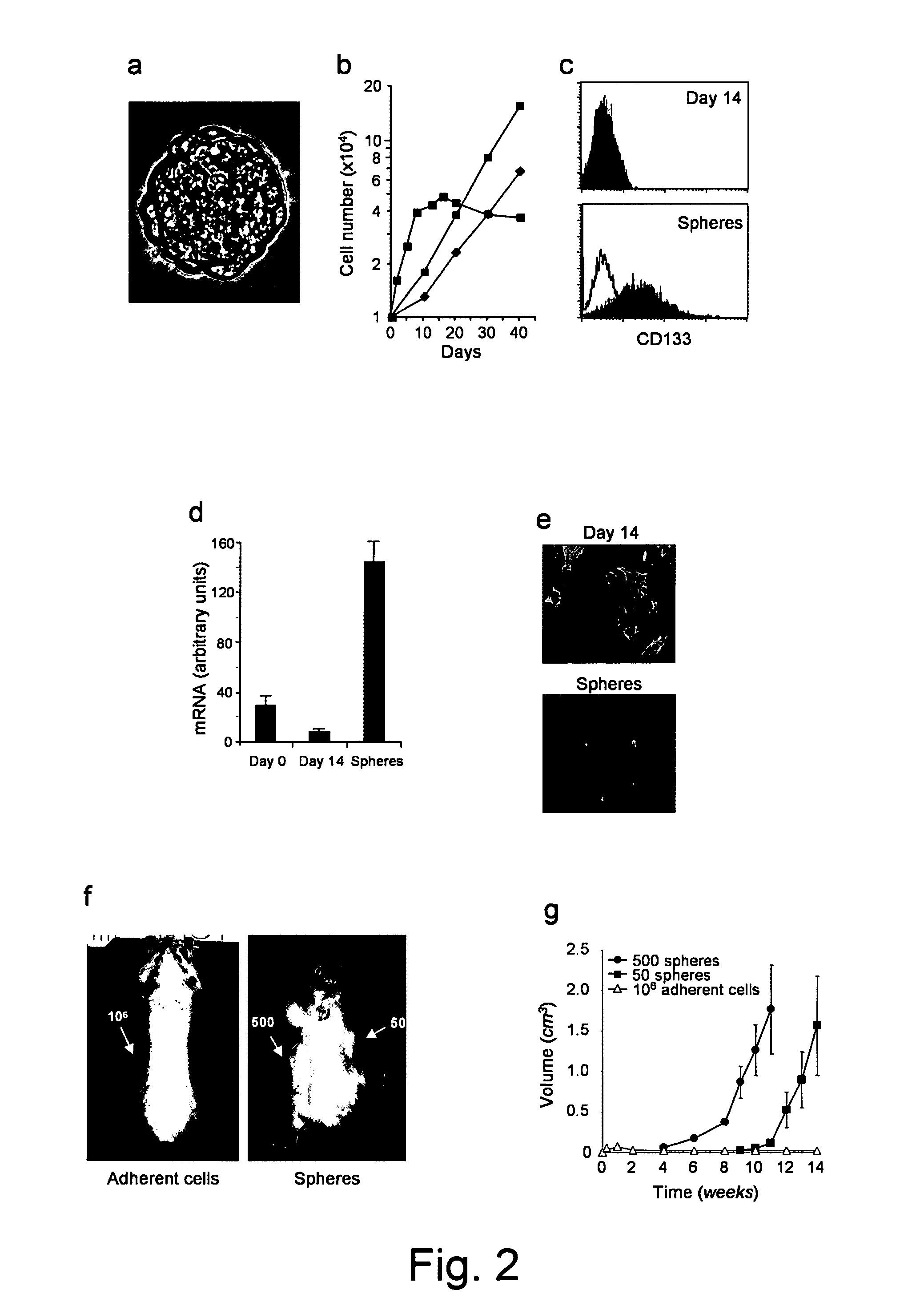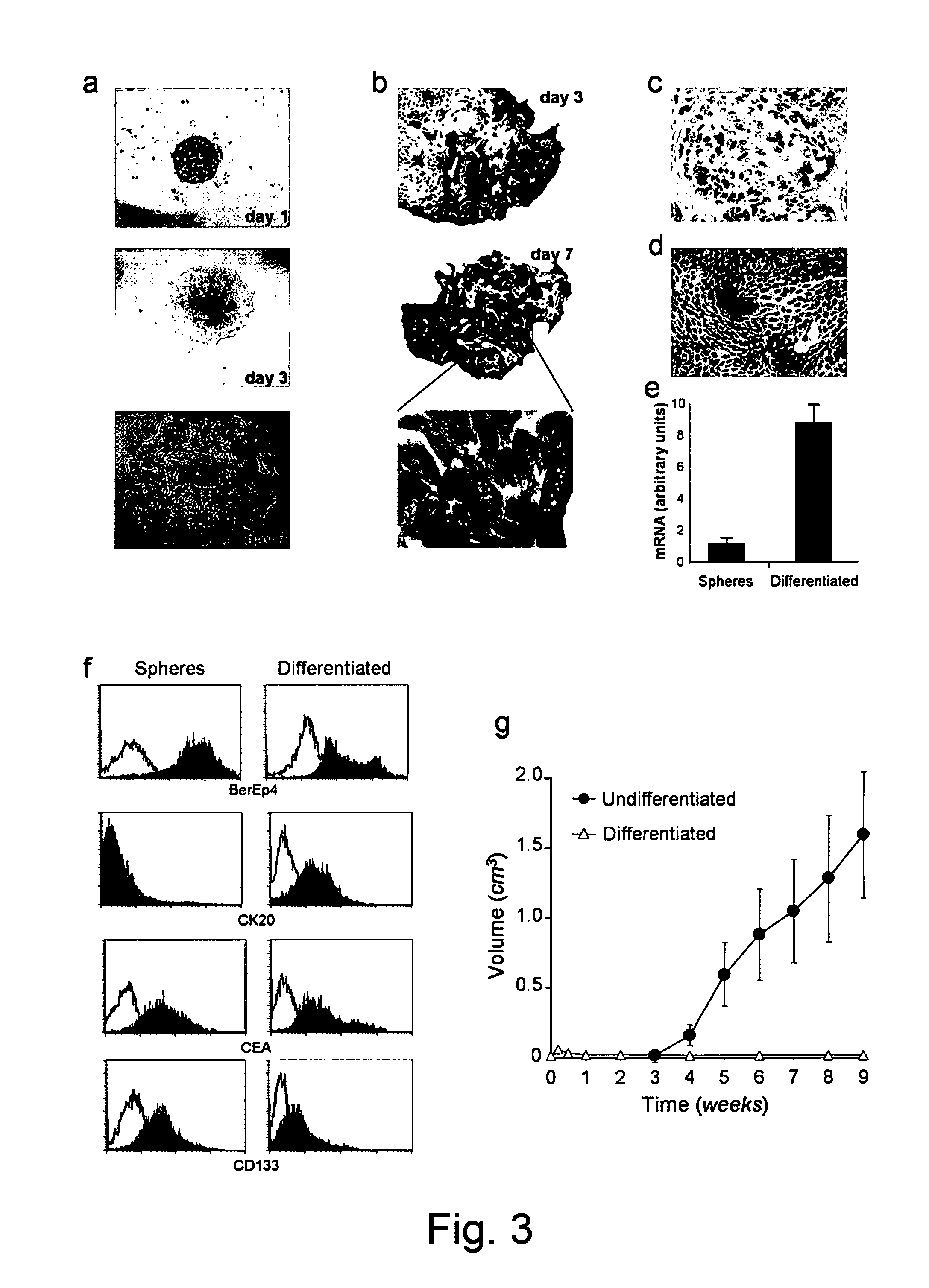Digestive System Cancer Stem Cells and Tests and Uses Therefor
a technology of digestive system cancer and stem cells, applied in the field of malignancy testing, can solve the problem of not being able to generate cancer stem cell cultures, and achieve the effect of increasing tumor aggressiveness and fast growth
- Summary
- Abstract
- Description
- Claims
- Application Information
AI Technical Summary
Benefits of technology
Problems solved by technology
Method used
Image
Examples
example 2
Other Cancers
[0119]Similar experiments were repeated for other cancer types in the digestive system, including pancreatic cancer. The protocols used in Colon cancer were repeated as appropriate.
[0120]Recent publications in this area include Li et al (Cancer Res. Feb. 1, 2007;67(3):1030-7. Identification of pancreatic cancer stem cells, Li C, Heidt D G, Dalerba P, Burant C F, Zhang L, Adsay V, Wicha M, Clarke M F, Simeone D M) and Ma et al (Gastroenterology. June 2007;132 (7):2542-2556 17570225 Identification and Characterization of Tumourigenic Liver Cancer Stem / Progenitor Cells, Stephanie Ma, Kwok-Wah Cha, Liang Hu, Terence Kin-Wah Lee, Jana Yim-Hung Wo, Irene Oi-Lin Ng, Bo-Jian Zheng, Xin-Yuan Guan).
[0121]The results of experiments done in respect of pancreatic cancer confirm that CD133+ are markers for pancreatic cancer and that tumour spheres containing CD133+ cells are tumourigenic in immunocompromised mice. These findings are shown in FIGS. 8 and 9:
[0122]FIG. 8. A) Pancreatic ...
example 3
Reproduction of Cancer Metastasis in Mice
[0125]Further work was carried out in respect of introducing tumour spheres containing CD133+ cells into immunocompromised mice. The introduction of CD133+ cells, originally isolated from colon cancer, as xenografts into the lungs of immunocompromised mice, led to the formation of colon-cancer metastases in the lung tissue. The same was also found in the spleen and peritoneum.
[0126]This is particularly useful in the provision of in vivo mammalian models, such as mice, with xenograft metastases and the study of such cancers.
[0127]Also of note is that the CD133+ cells can be introduced both at the desired site by orthotopic injection, for instance, or by introduction into the blood, as was the case for the lung metastases.
[0128]Method:
[0129]A representative of multiple independent experiments is shown. Tumour formation was observed after 4-12 weeks of injection. The time required for tumour growth was related to the number of cells injected. A ...
example 4
Suitable Conditions for Cultivating CD133+ Cells
[0136]An example of suitable conditions for cultivating CD133+ gastrointestinal tumour cells is described below.
[0137]Tumor samples are washed several time with phosphate buffer saline (PBS) at room temperature and incubated overnight at 4° C. in DMEM-F12 containing 25 units / ml of penicillin, 25 mg / ml of streptomycin and 10 mg / ml amphotericin B. The day after, samples are subjected to mechanical dissociation followed by enzymatic dissociation in DMEM-F12 containing 1.5 mg / ml of collagenase I, 20 mg / ml of DNase I and 500 mg / ml of hyaluronidase, for about 30-60 min depending on sample size. At the end of the enzymatic digestion, cell suspension is filtered by using a 100 mm nylon cell strainer. The resulting cancer cells are cultured in NS-A basal serum free medium containing 2 mM L-glutamine, 0.6% glucose, 9.6 mg / ml putrescine, 6.3 ng / ml progesterone, 5.2 ng / ml sodium selenite, 4 mg / ml heparin sodium salt, 100 ng / ml hydrocortisone, 0.02...
PUM
| Property | Measurement | Unit |
|---|---|---|
| Fraction | aaaaa | aaaaa |
| Fraction | aaaaa | aaaaa |
| Fraction | aaaaa | aaaaa |
Abstract
Description
Claims
Application Information
 Login to View More
Login to View More - R&D
- Intellectual Property
- Life Sciences
- Materials
- Tech Scout
- Unparalleled Data Quality
- Higher Quality Content
- 60% Fewer Hallucinations
Browse by: Latest US Patents, China's latest patents, Technical Efficacy Thesaurus, Application Domain, Technology Topic, Popular Technical Reports.
© 2025 PatSnap. All rights reserved.Legal|Privacy policy|Modern Slavery Act Transparency Statement|Sitemap|About US| Contact US: help@patsnap.com



